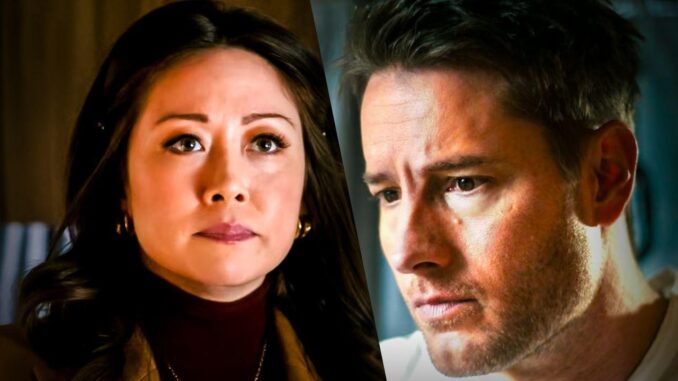
It’s not that Colter won’t run into a serial killer or catch a dead body now and then – that much is inevitable in his line of work. Still, Tracker season 2 was excessive with murder and gore, especially in the second half of the season once it returned from its midseason hiatus. There wasn’t any reason to be, either, with season 1 having been so popular.
I’m not one to get squeamish or turn down a dark storyline, but binging Tracker season 2 made it starkly clear just how dark this season was compared to season 1. Where the first season had some levity and some lighter but still engaging episodes, such as the missing thoroughbred racehorse, the back half of season 2 was a pretty bleak affair, especially when watching it all in one go. While Tracker season 3 doesn’t have to go back to season 1’s relative lightness, a happy medium between the first two seasons would be ideal and help keep it from being repetitive, as a few episodes this season felt.
If you’ve been following Get Rid Of The Rampant Murder & Serial Killing (GRRM&SK) Season 2, you’ve probably felt the shift. The tone plunged deeper into dark, gritty territory, leaving many fans wondering — did the show really have to go that far? Today, we’re diving into why Season 2 took such a dark turn, how it affected the story, and ways it could’ve stayed gripping without losing its soul.
Why Did Season 2 Go So Dark?
Every showrunner faces pressure to outdo the last season, but sometimes, pushing boundaries means pushing darkness. Season 1 of GRRM&SK was tense and thrilling but maintained a balance between suspense and story. Season 2? It leaned heavily into bleakness — graphic violence, twisted characters, and an almost hopeless vibe that left viewers emotionally drained.
The Desire to Shock and Surprise
Part of the reason? Shock value. Dark twists are a quick way to grab attention and spark conversation. But when dark becomes relentless, it risks alienating the audience.
The Impact of Darkness on Character Development
Season 2’s darkness didn’t just show in the plot — it seeped into the characters. Previously nuanced heroes became shadows of themselves, while villains grew cartoonishly evil. This imbalance hurt the emotional connection viewers had built.
How Could Season 2 Have Balanced Darkness with Story?
Balancing darkness and story isn’t about watering down themes but about thoughtful storytelling. Here’s how Season 2 could’ve kept its edge without losing fans:
1. Maintain Character Depth
Keep complex characters who struggle with their inner demons but aren’t defined solely by them. Dark moments should reveal, not erase, humanity.
2. Use Darkness Purposefully
Dark scenes should serve the plot or character arcs, not just shock. Every grim twist should propel the story forward.
3. Offer Moments of Hope
No story thrives in total darkness. Even in bleak settings, small victories or moments of light make the darkness more impactful.
Why Fans Reacted So Strongly to the Darkness
Viewers connect to stories emotionally. When a show becomes overwhelmingly dark, it risks exhausting its audience’s emotional reserves. The fatigue from nonstop grimness can lead to disengagement or backlash, even if the plot is compelling.
The Role of Pacing in Managing Dark Themes
Pacing plays a crucial role. Season 2’s relentless dark tone felt like a constant punch, with little reprieve. Good pacing weaves tension and relief, building suspense while preventing burnout.
What the Show Got Right in Season 2
Not everything was lost in darkness. The writing still held moments of brilliance — clever dialogue, intense plot twists, and striking cinematography that enhanced the mood without overwhelming.
The Importance of Audience Feedback
Showrunners sometimes overlook the importance of audience feedback during production. Social media and fan forums are treasure troves of insight. Listening to viewers could have helped steer Season 2 back toward a more balanced narrative.
The Influence of Competitors and Trends
The entertainment landscape is flooded with dark thrillers, some so extreme they almost glamorize violence. GRRM&SK may have felt pressure to follow this trend to stay relevant but fell into the trap of over-darkening its tone.
Could Season 3 Rebound?
Absolutely. Season 3 has the chance to restore balance, reintroduce hope, and deepen character arcs without losing suspense. Learning from Season 2’s pitfalls can revitalize the series.
Lessons for Writers and Producers
The GRRM&SK Season 2 experience offers valuable lessons:
-
Darkness for darkness’s sake rarely works.
-
Characters must remain relatable.
-
Balance suspense with emotional reprieve.
-
Listen to your audience early and often.
Viewer Tips: How to Enjoy a Dark Show Without Burning Out
If you love gritty thrillers but want to avoid emotional fatigue:
-
Take breaks between episodes.
-
Discuss episodes with friends or online communities.
-
Balance watching with lighter shows or activities.
-
Reflect on what the darkness means for the characters and themes.
Is There a Line Between Dark and Too Dark?
Yes. Dark storytelling is about exploring the human condition, not just shocking viewers. When darkness overshadows story and character, it stops being art and becomes a gimmick.
The Power of Storytelling Beyond Darkness
Great storytelling shines brightest in contrast. Darkness is compelling when it highlights the struggle for light — hope, redemption, or justice. Season 2 lost that contrast.

What Fans Hope to See Moving Forward
Fans want a Season 3 that respects their emotional investment — thrilling, complex, and yes, dark, but balanced with humanity and hope.
Conclusion
Get Rid Of The Rampant Murder & Serial Killing Season 2 had the ambition to deepen its story through darkness but took a step too far, leaving many fans overwhelmed and disconnected. Darkness in storytelling isn’t inherently bad — it’s a powerful tool when wielded with care. Season 2 teaches us that balance is key: dark moments must serve story and character, not just shock. As fans eagerly await Season 3, the hope is for a return to nuanced storytelling that respects both its subject matter and its audience.
